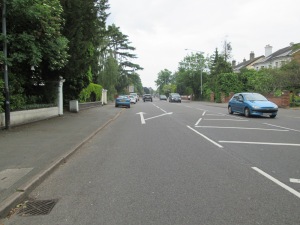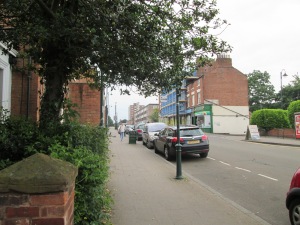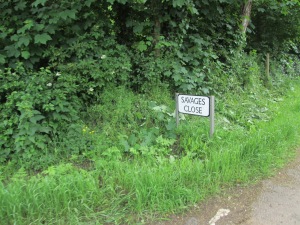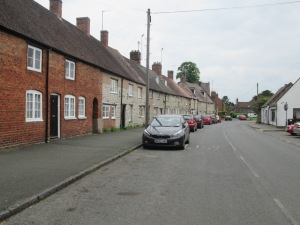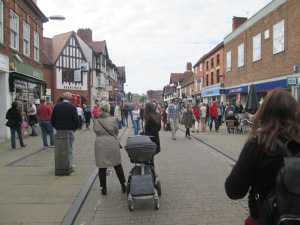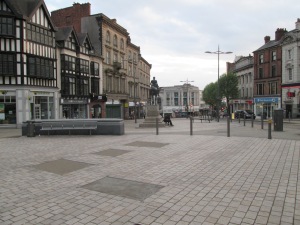“It’s got a lovely history and heritage. Shame it’s a shit hole now” – Ian, Wolverhampton.
There’s a shared experience of pessimism among the people I’ve so far met. At first it comes across as ironic: why would you want to come here?! As conversation progresses, this pessimism breaks down into either a belief that the area’s recently fallen on hard times due to some particular influx of immigrants. Or, the belief is soon retracted after a moment’s reflection: no, it’s not really that bad, it’s just got a reputation. Either way, pessimism is the most common expression people tend to make about their environments, and about society as a whole. This pessimism and cynicism remains a major obstacle to establishing a belief in social change.
One thing that also increasingly occurs to me, and from some of my interactions so far, is a common dislike of eastern European immigrants. It strikes me as a kind of safe racism, one that can negatively characterise a huge group of people whilst seemingly not being prejudiced (they’re white, like us). I am also finding this increasingly worrying.
I awake in Earlsdon. My friend Stephen send me away with a full belly of scrambled eggs on toast and a little packed lunch. The weather is typically grey and overcast, but at least there’s no rain to contend with. I swerve up and down small hills out of Cov, red-brick terraced houses gradually giving way to a more common and dull mock-Tudor detached home with driveway. My route skitters by the University of Warwick, before heading out to Leamington.
The countryside is increasingly lumpy. A steep hill gives way to an eye-watering fall, making the cycling a little more dramatic. I pass through the beautiful Warwickshire countryside, past signs that point one way to the crematorium, the other to a wedding, swinging between both major existential moments on a country by-road. I am close again to Fosse Way again, the land’s Roman colonial legacy still etched into the country in points like these.
Lichen coats the road-signs here, a thick green fuzz that is impossible to remove with one’s finger. A seemingly meaningless and everyday occurrence like this can be rich with stories however.
Patrick Keiller is a British filmmaker and writer whose three Robinson films dedicate especial attention to seemingly mundane parts of the British landscape through their long single-scene shots and rambling commentaries. Lichen like this, Keiller suggests, possess a unique kind of non-human intelligence. Often living for thousands of years, they are not a single creature but a symbiotic relationship between a fungus and a photosynthetic partner, usually green algae or cyanobacteria. They can thrive anywhere, and seem to have the capacity to survive all manner of environmental collapse.
Lichen seem to indicate the importance of working out a symbiotic relationship with one’s environment to survive. But for Keiller, and for another curious British thinker, James Lovelock, they indicate what life might be like after the mass extinction of human beings through ecological collapse. Lovelock expects that the majority of humanity will have died out through such collapse by the start of the 22nd century. It is most strange, and curious, that among such tranquil scenery and seemingly boring natural stuff like lichen that one gets a shortcut to the apocalypse.
But I am daydreaming in front of a lamp-post. It’s the time to move.
I reach Leamington, famous for its therapeutic spa. As I pass nursing homes and Christadelphian chapels, I spot the pretty Georgian style that characterises the town. The place is a little pretty, though quite full of tourists wandering up the main street, carrying folded-up hiking sticks and empty backpacks.
The Royal Pump Rooms were opened in 1814, and soon after the town boomed. Belief in the therapeutic benefits of bathing in the spa waters seemed to take over the functions of the medieval pilgrimage several hundred years earlier. People would travel some distances in the hope of a cure through the vague powers of the water.
Celia Fiennes was one of these, and is a fascinating pioneer of women’s equality and independence. She travelled all around England by horse during the late 17th century, ostensibly to test therapeutic waters for her bad health, but I expect with a love of travel too. She wanted to ‘cure the evil itch of over-valueing foreign parts’ by writing about her experiences in detail. Fiennes is a curious character. Travel writing becomes part of a civilising process in her work. She aimed to reveal ‘the nature of the Land, the Genius of the Inhabitants, so as to promote and improve Manufacture and Trade suitable to each and encourage all projects tending thereto’. She continually makes recommendations about improving land economically as she passes.
But she also seems to want to civilise the rough people she comes across. She describes the ‘clounish rude people’ of Castle Cary, and later, with Ely farmers, ‘they are all a lazy sort of people and are afraid to do too much’. Daniel Defoe wrote a little later but takes a similar agenda. He saw trade as the greatest national good, and his travel notes are rich with suggestions about how to make economic profit from the land. Although Defoe has a love of the strange and grotesque, what we read is a travel story deeply coloured by the writer’s preoccupations.
This leads back to this project. My friend Stephen wrote a very thoughtful response to my Coventry entry which can be read here: http://thanksforyourears.wordpress.com/2014/06/01/j-d-taylors-searching-for-albion-project/.
Stephen rightly indicates that there are limitations and dangers with my method for finding out and then reproducing what people tell me of their lives and areas. Short conversations are insufficient, and people are likely to exaggerate, lie, or downplay with pessimism what they think to an enthusiastic stranger. He’s concerned that:
‘Dan will only ever get the superficial-visual side of a place, and even in the stories people tell and in the insider-informant perspective of citizens, Dan will only ever get the version that people wish to project of their home town’.
It’s true that my findings will always be limited here, and will limit what is edited and presented as ‘Leicester’, ‘Coventry’ or elsewhere. I can’t quite get round that, but I think it’s important to be clear that what I write is a series of my own impressions and notes of a place. Others who might undertake my journey would probably encounter different things. Nor are my notes meant as proper knowledge of a place. Just like Fiennes and Defoe, my writing reflects my own preoccupations. It’s not meant as a kind of civilising process, but it’s clear that as I write, my interest is in finding out how people survive in an unfair society. I’m already aware that most of the people I meet don’t share many of my political beliefs. Everything here comes in my colour. But Stephen writes off with a recommendation worth sharing: to capture the Britains left behind, much more must be done than simply passing through in half a day. Research, maybe. I think something more though.
Getting back to Leamington. The town is nice if somewhat dull, and I find more character towards the south past the train station, towards Bishop Tachbrook, where a more lively and multicultural series of shops and communities present themselves. I pass barbers, street drinkers and Polish food shops, perhaps the closest residue (beyond a small plaque) to the presence of the Free Czechoslovakia Army, improbably based in this little town during the Second World War.
I leave Leamington and take the road south to Kineton, across rolling hills and fields packed with wheat. There is a quiet and pretty market town here, but I am not here for that.
I’m ghost-hunting. I seek out signs of the battle of Edgehill, a battle so inconsequential it reflects the wider course of the English Civil War. This island’s civil war is barely known by the public beyond the names Oliver Cromwell, Cavalier and Roundhead, but once presented an opportunity some 360 or so years back for common men to demand democratic rights and a form of written constitution that would render all men equal. Many believed that the world would end and that Jesus Christ would come down and reign over earth for a thousand years, a belief that would inspire many to combine iconoclasm and political radicalism with an extreme religious zealotry.
There are no monuments I can find here, and one has to envision the confusion in the town’s surrounding slopes. The two sides more or less stumbled on each other in October 1642, and entered into a badly-organised scuffle. Many were barely equipped to fight, and so fled the scene, looting from the other side’s baggage as they did.
This first pitched battle led to little. Seven years after outright victory, Oliver Cromwell dies in 1658, little more than a military dictator over a disunited country, the opportunities for political and social transformation all but lost. Two years later, Charles II is offered the throne by the Army. Simply removing an authority without making lasting constitutional arrangements for a new society often ends similarly, with a bitter restoration of the traditions of the past. But on a lighter note, there is a funny coincidence that many historians of this period are also secret nerdy members of battle re-enactment clubs. There truly is no impartial side in history.
I eat my packed lunch by a war memorial as convertibles skid by. My next destination is Stratford-upon-Avon, where the road takes me past strange flowers and plants that have a wonderful, soap-like smell. I pass cyclists heading the other way, and to each we nod or greet each other, a polite and friendly cycling code which I’ve never come across in London. It’s fantastic.
Stratford is quite full of cars and coaches when I arrive, and as I cycle down into the town centre, the place is heaving with tourists. The pretty canal area is packed with visitors licking ice creams and picking at polystyrene boxes of fish and chips, whilst in the distance I see the attractive modern orange-brick building of the Royal Shakespeare Company doing a good trade. All around me are guests from across the world, particularly American and Japanese visitors. A busker appears nearby with a sound-system and a coat already full of 50 pence pieces.
Perhaps the one interesting thing by the canal is a statue of Hermaphroditus, crafted in 1844 for the Great Exhibition at Crystal Palace. The story is a powerful allegory for a specific kind of love that is one of life’s greatest joys, of the mutual bond of an intense and wonderful relationship. Hermaphroditus grew up into a beautiful young man who left his homes and wandered the world. One day he came across a pool where Salmacis, a water-nymph, lived. Salmacis’s attempts to seduce Hermaphroditus fail, but not giving up easily, she hides away. When Hermaphroditus later enters the pool of water for a wash, Salmacis jumps out and wraps herself round him and makes a wish to the gods that they never be parted. Thus they became a creature of two sexes. A more intriguing story would be what happened next to this intense pair…
I wander on, unable to fit on the pavements for the sheer quantity of tourists dawdling at the pace of dripping drool. I pass bloody awful shops that repeat themselves street by street, and enter a series of roads that represent mock Tudor on crack. I first call into Nash House on Chapel Street, next to New Place, bought by Shakespeare in 1597 at a time when his theatre company were enjoying great successes in London.
I have come to the town to find out a little more about Shakespeare, this curious national heritage of ours. He returned here around 1608 and retired. In these final years back in Stratford, he also set down his sonnets. They resist all the clichéd characterisations of this national treasure. They are mostly addressed to a male ‘fair youth’, often using romantic language that would indicate a homosexual relationship (‘shall I compare thee to a summer’s day?’). Alongside these are more obviously sexual poems to a ‘dark lady’, and reflections on jealousy, and dying. They remind us that in the time of Shakespeare, the theatre was an illicit institution, where men could dress as women and express new identities, a drag show for the 16th century.
Love becomes intimate and complex in Shakespeare, and I like him best when he speaks of love. Giving Anne Hathaway his second-best bed was a wryly poetic ranking of their sex life. The fluidity of gender roles and polysexual feelings openly described in the sonnets is remarkable. At the same time, Shakespeare is doing something a little similar to Thomas Browne, our man in Norwich. Ancient Greek and Roman poetry and philosophy contained a good deal more bawdiness, unruliness and alternative ways of thinking about the world than we might today grant the ‘classics’. In the hands of Shakespeare or someone else, these classic accounts of sexual desires could be told anew.
I’m inclined to visit but the entry-prices of these attractions is staggering. I wander round the streets of the town, finding the place where he is thought to have grown up, surrounded by grinning tourists photographing anything that doesn’t move and shops selling London tat.
‘Foolery, sir, does walk about the orb like the sun; it shines everywhere’ — Twelfth Night.
I must escape these tourists. I cycle out of town, passing the train station. Behind it, Stratford suddenly becomes quite down-at-heel, now offering the usual retail park of high-street brands. The road weaves through Henley, a posh and pretty little town, before weaving through the verdant and delightful Arden forest, rich with scents.
It’s a long journey ahead, and my goal is to reach Wolverhampton via Birmingham. I struggle up and down the juddery and bumpy hills. I’ve become dependent on eating real junk food, like big packs of biscuits and cakes, in order to quickly get the calories and sugar to make it up these hills. What is a social catastrophe – the heavy-marketing and discounting of junk foods, creating malnutrition and obesity among the poorest – is right now aiding me to climb these hills.
It’s not until Eastwood that I began to hear what sounds like a Birmingham accent. I pass by some fishing lakes, where a couple of lads idly gaze at the water and share a spliff. As I get to Hollywood, I take a stop and absorb the surroundings. People are really polite to each other, each person greeting the other. An Indian shopkeeper pops out to talk to passing by one local man, and they discuss the pools. It is all quite unfamiliar.
As I travel further, I realise just how huge the West Midlands really is. Unlike London, it’s hard to determine whether these countless towns surrounding Birmingham are suburbs of it. They seem instead to have taken on a suburban identity of their own accord, and could easily be attached to Solihull, Walsall, Wolverhampton or elsewhere. This identity they take is remarkably uniform. As I cycle into Birmingham I pass perhaps the most unremittingly consistent sets of appearances of houses. They are pure British code: suburban semis, pebble driveway, satellite dishes, bird-feeders and passive aggressive signs. As J.G. Ballard would put it, this is quite an ‘uncentred’ place.
The battering my wheels start to take from pot-holes is a reassuring indicator that I’m at last coming close to Birmingham. I pass through Kings Norton and then Selly Oak, before reaching Bournville, built by George Cadbury as a model community for his chocolate workers. Cadbury built the place at his own expense between 1893-1900 to ‘alleviate the evils of modern more cramped living conditions’. The houses were built in a pretty arts and crafts style, and a community was built that could provide the personal and social needs of workers (though there were no pubs!). Public baths, a museum, schools and places of worship, and plenty of outdoor exercise spaces were factored into the design of this pretty, village-like community. If only the town planners of the 1960s had attempted to emulate this in some way. Bournville is not a set of houses or streets, but a built community. Cadbury’s benevolence seems entirely out of kilter with the more naked greed and tax evasion of industrial leaders today.
I pass through Harborne along well-planned and integrated traffic. I stick with A-roads, weaving by Dudley, home of Lenny Henry but today little else and much run-down. Lenny Henry’s life seems to straddle many of the jarring identities and time zones of the area. He started as a stand-up comic from a young age, playing to working men’s clubs and Blackpool’s summer season. He was involved in the Black and White Minstrel show, but regretted it later, of course, but his act reflects changing forms of popular entertainment. Racism was so casual and quotidian that golliwogs and ‘blacking up’ were felt to be harmless. Race has divided the area: there were race riots in Dudley in July 1962, when white man attacked black immigrants in a way that shadowed the Notting Hill riot four years earlier. Later in 1991, whites and Asians rampaged against each other. We should be proud of the great strides towards multiculturalism that have been made since the 1960s and 70s, and reflect that there is still some way to go to include new visitors. His act moved from stand-up to small, working-class audiences in local clubs, and involved often impersonating white people, to today being the face of the service industry, Premier Inns, and countless TV sitcoms and DVD stand-ups. I would like to see a statue to him around this run-down place.
The road takes me past continual industrial warehouses, suburban semis, retail parks, and the odd well-designed if remote council estate. After some time, and with the sun setting, I make it to Wolverhampton. There is a change of mood initially, as the houses on the suburban periphery are quite shabby and some derelict, and many businesses are boarded up. But as I arrive closer, I enter an impressive town with some rich, beautiful public architecture and stories.
The place is very multicultural, from Polish men carrying sleeping bags and cans of beer to betting shops full of older Afro-Caribbean men, to toy bat goth pubs and insane Irish bars like McGees, where karaoke continues all night. It has a great sense of fun. I arrive on a Saturday night, and though the centre is at first quiet, I pass people dressed up as animals, and quickly enter a lively beer garden at the Posada, where my friend Kerry lives upstairs. I’m quite tired, and struggle to keep up with the conversation. People in Wolves tend to speak very quickly, and carry with them quite a sharp sense of wit which I find tough to follow.
But I am tired. Before going back in, we watch drunks fight and shout at each other by the McGees Irish bar as a happy drunk murders ‘Come on Eileen’, before heading upstairs inside the old pub. It is a cosy place, full of bonkers cats and the most extraordinary ornaments. I get a good night’s sleep, only occasionally interrupted by the shouts and cheers of revellers into the later hours of the morning.











